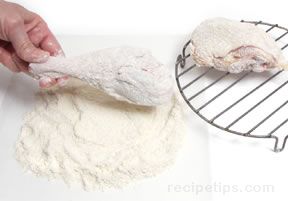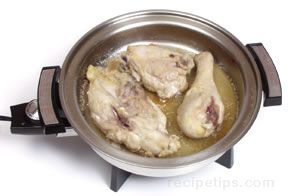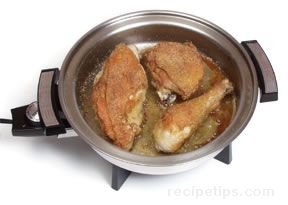|
Frying chicken is a quick and simple way of cooking chicken where the cooking can be accomplished by the use of two different methods, pan-frying and deep-fat frying. Both methods work on the principle of using hot oil to cook the chicken, producing chicken with a crispy brown outside and juicy, flavorful meat inside. The chicken is generally coated with a thin layer of flour, crumbs or batter. Chicken pieces are generally used for frying, rather than a whole chicken.
Pan-Frying: When pan-frying, a heavy skillet with deep sides is generally used. The chicken pieces are coated with flour that has been seasoned with salt, pepper and at times, paprika. It can also be seasoned with other spices, such as chili or curry powder, marjoram, oregano, basil, thyme, and rosemary to create a desired flavor.
|

|
|
Once the chicken is coated, it should be placed on a rack to allow the pieces to dry, which may take 20 to 30 minutes. Allowing the pieces to dry will provide for more even browning of the chicken. |
|
To fry, heat 5 or 6 tablespoons of oil in a heavy skillet over a medium-high burner until the oil is very hot. Place the chicken pieces in the hot oil, skin side down, one piece at a time. Leave enough space between pieces so that they are not crowded. This allows the pieces to cook and brown more evenly. |
|
 |
 |
|
Continue to cook over a medium heat, turning until all sides are golden brown and the meat is cooked thoroughly. |
As the pieces finish cooking, they should be removed from the pan and placed on a paper towel to allow grease to drain.
The chicken can be checked for proper doneness using one of three methods. The best way to check for doneness is to use a meat thermometer. Chicken breast must reach 170°F and other pieces should be 180°F. If a meat thermometer is not available, a visual test can be performed by piercing the pieces with a fork. If thoroughly cooked, the juices should run clear. Doneness can also be checked by cutting into the thickest part of the chicken and making sure the meat is opaque all the way through.

Deep-fat Frying: The chicken pieces for deep-fat frying are generally coated with a crumb coating or a batter. If a crumb coating is used, the pieces should be set aside to dry for 20 to 30 minutes after they are coated. If coating with a batter, the pieces of chicken can be coated just before frying. When deep-fat frying, be sure the individual pieces are not too large. Large pieces of chicken are difficult to cook properly, resulting in an outside crust that is overcooked or an inside that is not cooked thoroughly.
To fry, fill a deep pan approximately half full of oil and heat to between 350°F and 375°F. To test the temperature, drop in a cube of bread, it should brown in 50 seconds if the oil is about 365°F. Using tongs or a metal spatula, place three to four pieces of chicken in the hot oil, being careful that they are not overcrowded. Cook until golden brown, approximately 6 to 10 minutes. As the pieces of chicken get done, remove them from the oil and place them on a paper towel to allow the grease to drain.
When using either method of frying, an important part of the process is keeping the oil at the proper temperature. Once the chicken is placed in the hot oil, the temperature of the oil will drop. But, as long as the oil continues to bubble consistently, it will cook the chicken properly. If the temperature of the oil would be brought back up to between 350°F and 375°F, the outside of the chicken would burn before the inside finished cooking. To prevent this from happening, the temperature may need to be turned down a little once the chicken starts browning, but make sure the oil stays hot enough. If the oil is not hot enough, the chicken will be greasy. Controlling the temperature of the oil is an important part of producing delicious fried chicken. Shown below are some additional tips on frying chicken.
- It is best to leave the skin on while cooking. If desired, remove before eating.
- When pan-frying, cover for the first 5 minutes of cooking and then uncover for the remainder of the cooking time. Covering for a short period of time will help cook the chicken thoroughly.
- Use tongs or a spatula instead of a fork when placing chicken pieces in the pan or when turning the pieces. Piercing the chicken with a fork allows the juices to escape.
- Be sure all utensils and equipment are dry before they come in contact with the oil. Water will make the oil splatter when heated.
- Using canola oil provides a milder taste, and it contains healthier amounts of saturated and polyunsaturated fats.
- Remove pieces of chicken from the oil as soon as they finish cooking. To keep the chicken warm while other pieces are cooking, set the pieces that are done on a baking pan covered with paper towels and place it in the oven at a low temperature.
- Do not cover the chicken once it has finished cooking, because covering will cause the coating to loose its crispness.
|

